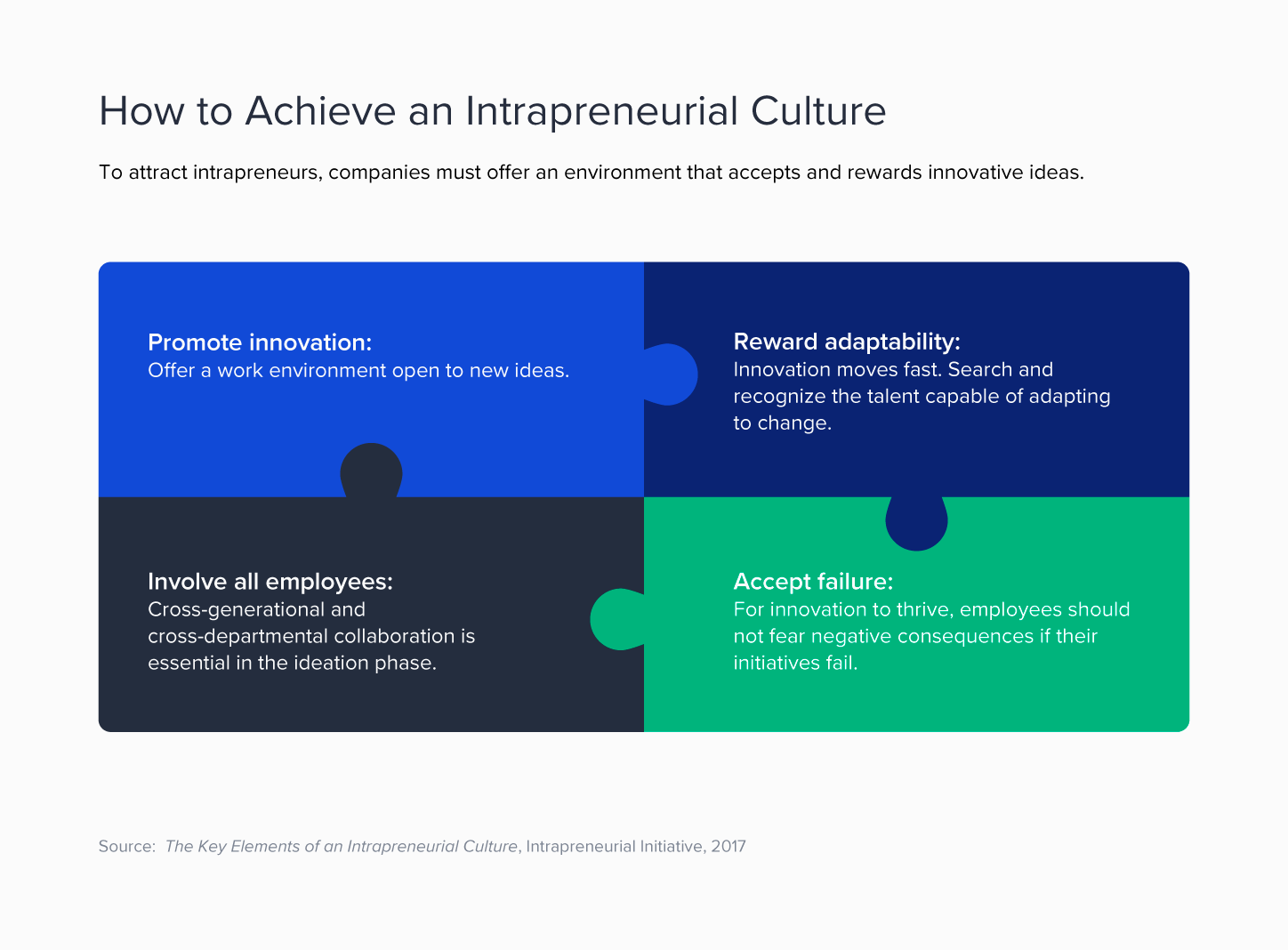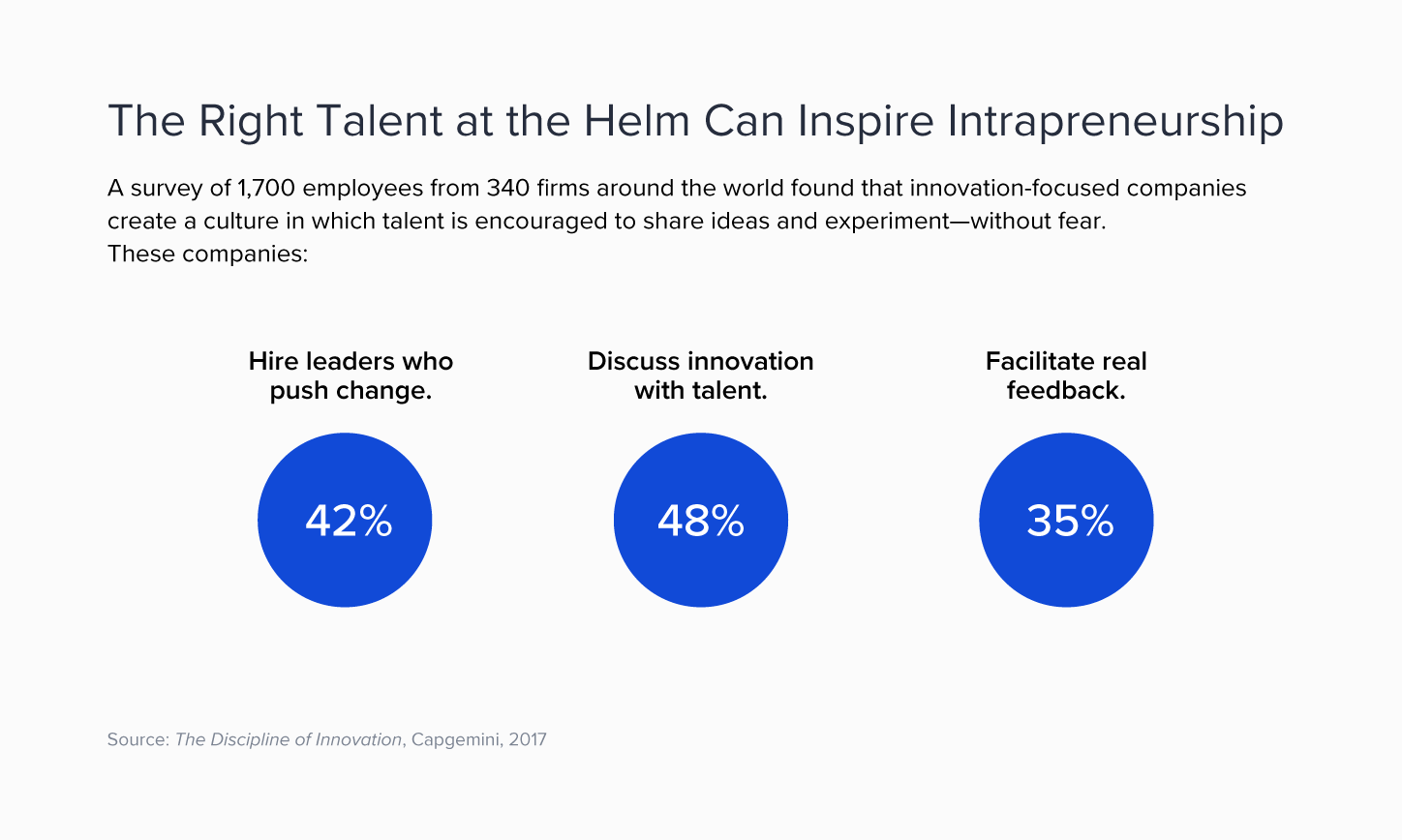4 Ways to Foster an Intrapreneurial Workplace Culture—From Experts at Cisco and Eversana
authors are vetted experts in their fields and write on topics in which they are extremely knowledgeable. All of our content is peer reviewed and validated by world-class professionals.

Featured Experts
As companies search for new ways to develop leaders, engage employees, and drive innovation, interest is growing in intrapreneurship as a specific approach to organizational culture. By empowering people at all levels of the workforce to cultivate an intrapreneurial, problem-solving spirit, leaders provide professional development, increase employee engagement, and build trust and autonomy, says Simone Ahuja, a keynote speaker and innovation strategist for Fortune 500 companies, and founder of the consultancy Blood Orange.
In addition to these workforce benefits, intrapreneurship can sometimes lead to innovative new products or lines of business, as was the case for Elizabeth Bieniek, an intrapreneur at Cisco who co-founded Webex Hologram, an immersive meeting and training platform. Cisco’s culture, in which creative thinkers are encouraged to ask “why” and “what if,” played an important role in the product’s successful launch, she tells Staffing.com.

Although Cisco has formal innovation programs, Bieniek built her team through her own intrapreneurial efforts to discover new opportunities to complement Cisco’s existing Webex video conferencing product. By engaging in one-on-one conversations with technologists, founders, and acquaintances outside the organization, Bieniek developed a deep understanding of the professional collaboration sector. As a result, she uncovered an important opportunity for Cisco: the chance to create an extended reality platform to offer users a more immersive context for meetings and training.
“The interest in intrapreneurship from organizations across sectors is increasing dramatically and will only accelerate further in the next year or two,” says Ahuja, whose consulting clients include leading companies like PepsiCo and Procter & Gamble. “This approach helps catalyze all the things companies are already on the hook for: to grow sustainably as a business, and to engage, develop, and retain your best talent. The focus on intrapreneurship and its impact is going to be massive.”
To find out how HR leaders and other executives can build a culture of intrapreneurship in their companies, Staffing.com spoke to Ahuja, Bieniek, and two other leading intrapreneurship experts—Chief Digital Officer of Eversana Scott Snyder, and Yamini Bangarusamy, Intrapreneurship Programs Manager at innovation consultancy L Marks. They say these four simple steps can help leaders start recognizing bold thinkers and nurturing fresh ideas.
Focus on Problem Solving, Not ‘Innovation’
The word “innovation” often evokes research labs, idea tournaments, and design thinking workshops. But research suggests that these traditional avenues frequently don’t yield new products or develop genuine intrapreneurship, says Ahuja. Building a supportive, leadership-driven intrapreneurship culture doesn’t require a huge budget and splashy initiatives. “You can start at a super micro level,” she says. “Just knowing that you can start small reduces overwhelm and keeps people engaged.”
One small shift companies can make is to de-emphasize “innovation”—a term loaded with preconceptions—and focus on problem-solving. As part of business as usual, Ahuja advises leaders at all levels of an organization to devote a few minutes at the start of each meeting to identifying problems and breaking them down into tiny chunks: “What are the pain points that you’re observing? What are the problems? Are there times when you ask yourself ‘why do we do it this way?’”
Bieniek, likewise, says the language that business leaders use can have unintended consequences, and that the word “innovation” can intimidate people and keep them from sharing new ideas. “Remove the stigma of ‘I’m an innovation person, so I have ideas’ or, ‘I’m not an innovation person, so my ideas don’t count’—and get down to conversation,” Bieniek says. “I think everyone can innovate. Just focus on each person. Ask them, ‘What are your thoughts on how we can improve this bit?’ Because guaranteed, everyone has ideas. Everyone can think, and that's really all innovation is.”
Snyder, the Eversana Chief Digital Officer and a senior fellow at The Wharton School, also encourages leaders to balance their desires for “big I” innovations—big, risky moves—with a focus on “little I” innovations—everyday improvements to efficiency and core business operations. The best intrapreneurs often start out by engaging in what he calls “little I” innovation, he says. Improving existing business processes can act as a proving ground where these bold thinkers build their skills as innovators, preparing them to innovate and execute bigger ideas in the future.
“Sometimes companies aren't very good at giving their employees permission to just innovate around the current experiences, products, services, or ways of operating,” says Snyder, co-author of Goliath's Revenge: How Established Companies Turn the Tables on Digital Disruptors. “[Leadership] becomes addicted to their current business model and way of operating, because it’s comfortable and it’s worked, and that very success can create blinders to needing to disrupt themselves to stay relevant.”
Train Managers to Identify and Support Intrapreneurs
To fully benefit from a culture of intrapreneurship, companies must actively seek out and learn to trust employees who have the ability to think big and the foresight to recognize emerging patterns in the business landscape, says Snyder. Part of that process involves training middle managers to identify and support these thinkers.
If it hadn’t been for her manager’s support and trust, Bieniek, who has been at Cisco for 16 years, says she might have left the company. Instead, she and her team spent seven years building and testing Webex Hologram.
Having tired of her former role negotiating partnerships, she told her manager that she wanted to focus on long-term strategy by having external conversations and documenting what she learned in a series of presentations and podcasts. “He gave me a long leash to explore that for a bit and see what would come of it,” she says. “It wasn’t necessarily an immediate career pivot."
Bangarusamy, the Intrapreneurship Programs Manager at L Marks, agrees that middle managers are key to a robust culture of intrapreneurship. She and her firm are reimagining the intrapreneurship support programs they provide for their clients, which have included BMW, Lloyd’s of London, and Sodexo, to focus more on manager training.
While support from the top is critical to an intrapreneurial venture’s success, middle managers play an essential role in both surfacing ideas and providing “air cover”—protection from internal pressures and rumors—during idea development phases, says Bangarusamy. “Employees might come up with a really good intrapreneurial idea, but they need to take that to somebody who can be a conduit between them and upper management.”
Managers can also lay a foundation for more inclusive brainstorming, adds Ahuja, particularly as more companies embrace remote work. “It’s not just the extroverts whose ideas come forward anymore, and it doesn’t have to be,” she says. “When you have a thoughtful guide, that person ensures ideas can be shared not just in meetings but asynchronously, through messaging tools or anonymous polling.”

Shift Performance Metrics Across the Organization
To make this cultural shift, leadership must demonstrate the value that the company is placing on intrapreneurial thinking and behavior. Creating new performance metrics and goals across the organization that incorporate and reward unconventional thinking sends a clear signal. These new metrics will look different at different levels of the corporate hierarchy:
- In the C-suite, leaders can set a goal to investigate and document opportunities beyond the current business model, and develop predictions about how the industry may change in the future, Bieniek suggests. “It’s hard when you are a leader, who is running an organization, and you’ve got thousands of employees, and you have to hit a number every quarter,” says Bieniek. “That is phenomenally challenging. However, if you want to be relevant, and continue doing that for many years down the road, carve out a little bit of your mindshare to focus on where you might be uncomfortable. What might you not know? Entertain the crazy and the wild. Just give it some breathing room to see if it could turn into something.”
- At the manager level, measuring intrapreneurship might include managers tracking how many new ideas people have brought to them—as well as which ones they’re supporting and how, advises Ahuja. Managers could also be tasked with documenting the identification of process-oriented problems and implementing creative solutions.
- For individual contributors, goals tied to intrapreneurship might include generating a certain number of new ideas or identifying and troubleshooting inefficiencies.
When an idea is pegged as worthy of further exploration, the team charged with developing it must also meet concrete milestones, says Bieniek. Whatever the metrics, it’s important to note that a hallmark of intrapreneurial culture is the celebration of learning. Even when a new idea proves to be unworkable, the knowledge gained in exploring it is, in itself, a success.
Whatever You Do, Follow Through
All the experts Staffing.com interviewed identified a lack of support from senior leaders and a failure to follow through as primary roadblocks to efficient intrapreneurship, often leading to what is known as innovation theater.
To combat this, Snyder recommends that companies set up a council or board to decide who should develop promising ideas, and how much time and resources should be invested—rather than relying on the person whose idea it was. For example, expecting a programmer who came up with a promising new digital product idea to develop a business plan for it without the proper support, sets them up for failure, erodes trust, and dooms a potentially great idea.
Providing marketing, business development, and other support to scope a potential new initiative not only demonstrates how much a company values new ideas, but also increases the likelihood that the idea will receive the attention needed to determine its real value, Bieniek says.
Support and follow-through also involve leaders recognizing the individuals and teams implementing process improvements, and intrapreneurs working on ambitious new products or lines of business. For the “little I” innovations in core business processes, managers and leaders should offer public praise, appreciation, and monetary incentives like bonuses when possible, advises Ahuja. Recognition is critical for keeping teams motivated and incentivizing others to bring forth ideas for improvement, she says.
Executives are beginning to think about intrapreneurship as a tool for developing leaders and empowering internal talent, not just a means to their next big moneymaker. When company leaders see the knowledge gained from exploring new ideas as valuable—even ideas that fail—the stage is set for true intrapreneurship and innovation.
The benefits of fostering an intrapreneurial culture may not immediately show up on a balance sheet. But, the experts Staffing.com interviewed say this shift is a critical ingredient for long-term corporate resilience and for developing the kind of organizational culture that the world’s top talent craves.


